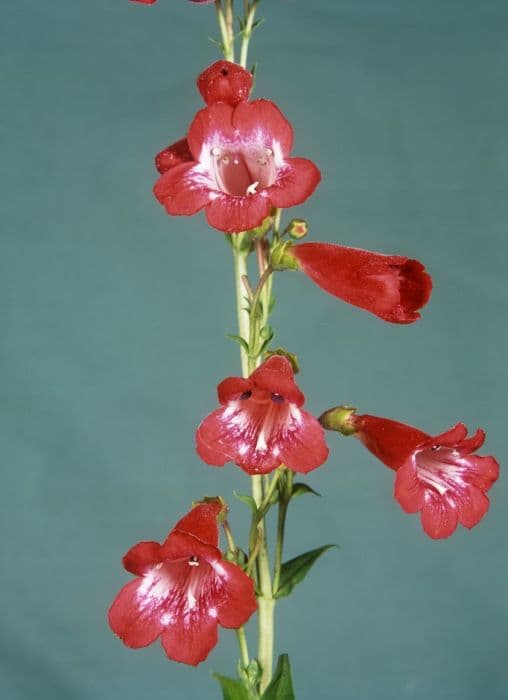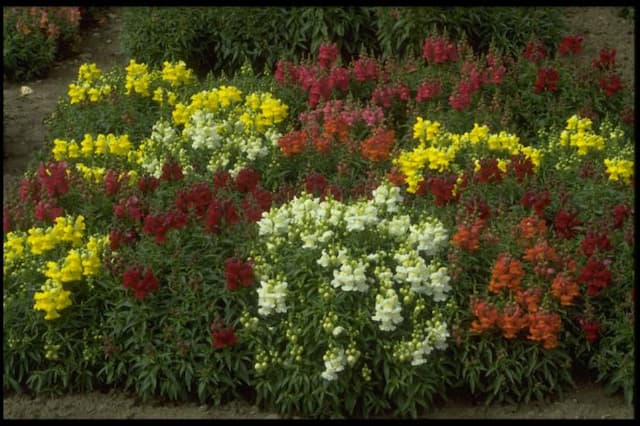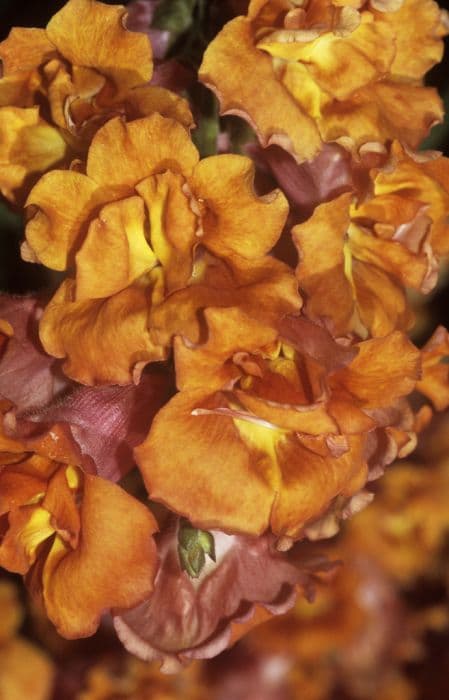Beard Tongue Penstemon 'Pensham Plum Dandy' (Pensham Series)

ABOUT
Penstemon 'Pensham Plum Dandy', commonly known as Beardtongue, features an attractive foliage of lance-shaped leaves that provide a lush backdrop for its flowers. The plant is admired for its striking tubular blooms that grace the garden with a blend of deep plum-purple colors. Each flower is distinct with a white throat that contrasts beautifully against the dark outer petals, creating a bold and dramatic effect. The blossoms are arranged densely along tall, upright stems, adding vertical interest to garden beds and borders. The blooms are known to attract pollinators such as bees and hummingbirds, adding not only visual delight but also contributing to the ecological health of the garden. Beardtongue typically flowers in the late spring to early summer, offering an extended display of its vivid blossoms that can enliven any garden space.
About this plant
 Names
NamesFamily
Plantaginaceae.
Synonyms
Beardtongue, Plum Dandy Penstemon.
Common names
Penstemon 'Pensham Plum Dandy'
 Toxicity
ToxicityTo humans
Beardtongue, including the variety 'Pensham Plum Dandy', is generally considered non-toxic to humans. This means that ingesting parts of the plant, such as the leaves or flowers, typically does not result in harmful effects or symptoms of poisoning. However, it's still recommended to avoid consuming plant material that is not meant for dietary use.
To pets
Beardtongue, specifically the 'Pensham Plum Dandy' variety, is not known to be toxic to pets. Therefore, if pets were to ingest parts of the plant, they are not likely to experience symptoms of poisoning. Still, it's always best to prevent pets from eating ornamental plants, as they can sometimes cause mild gastrointestinal upset simply because they are not part of the animal's normal diet.
 Characteristics
CharacteristicsLife cycle
Perennials
Foliage type
Deciduous
Color of leaves
Green
Flower color
Plum
Height
2-3 feet (60-90 cm)
Spread
2 feet (60 cm)
Plant type
Herb
Hardiness zones
4-9
Native area
North America
Benefits
 General Benefits
General Benefits- Attractive Flowers: Penstemon 'Pensham Plum Dandy' produces vibrant, plum-colored blossoms that add a splash of color to any garden.
- Pollinator Friendly: The tubular flowers are known to attract bees, butterflies, and hummingbirds, which are beneficial for pollination.
- Drought Tolerant: Once established, it has good drought resistance, making it suitable for xeriscaping and water-wise gardens.
- Low Maintenance: This plant requires minimal care once it is established, needing only occasional watering and deadheading to encourage more blooms.
- Long Blooming Season: It has a long flowering period from late spring to early fall, providing extended interest in the garden.
- Hardy Perennial: Penstemon 'Pensham Plum Dandy' is a hardy perennial that can survive in a range of climates, offering reliable performance year after year.
- Versatile Use: Suitable for borders, cottage gardens, and containers, this plant's versatility makes it a valuable addition to various garden designs.
- Deer Resistant: It is generally resistant to browsing by deer, making it a good choice for gardens in areas with deer populations.
 Medical Properties
Medical PropertiesThis plant is not used for medical purposes.
 Air-purifying Qualities
Air-purifying QualitiesThis plant is not specifically known for air purifying qualities.
 Other Uses
Other Uses- As a natural dye: The flowers of Penstemon can be used to create natural dyes for fabrics, imparting subtle shades of color.
- In art and crafts: The vibrant blossoms can be pressed or dried to create decorative elements in scrapbooking, card making, and other paper crafts.
- Photography subject: Penstemon flowers are popular subjects for photographers due to their striking colors and shapes, useful for practicing macro photography skills.
- Garden thematic designs: Penstemon can be used to create a 'Plum Dandy' themed area in gardens, paired with other purple and plum-colored plants.
- Eco-printing: Leaves and flowers can be used in the process of eco-printing, a technique where plant materials leave prints on fabric or paper.
- It is used as a teaching tool for botany or horticulture courses to illustrate plant growth, pollination, and the importance of perennial plants in garden landscaping.
- In culinary presentations: Although not commonly consumed, the flowers can be used as edible garnishes for their aesthetic appeal in culinary dishes.
- As a companion plant: It can be planted alongside vegetables and fruits to attract pollinators and improve the yield of the crops.
- In potpourris: The flowers can be dried and added to potpourri mixes for their appearance and subtle fragrance.
- As floral arrangements: Fresh or dried Penstemon flowers can be incorporated into bouquets and arrangements for a rustic or cottage garden style.
Interesting Facts
 Feng Shui
Feng ShuiThe Penstemon is not used in Feng Shui practice.
 Zodiac Sign Compitability
Zodiac Sign CompitabilityThe Penstemon is not used in astrology practice.
 Plant Symbolism
Plant Symbolism- Strength and hardiness: Penstemon, also known as Beardtongue, is a robust plant that is able to withstand tough conditions, symbolizing resilience and tenacity.
- Beauty and diversity: With its 'Plum Dandy' variety showcasing vibrant purple hues, it signifies the appreciation of beauty and the richness of variety.
- Openness and communication: The open bell-shaped flowers of the Beardtongue symbolize openness to new ideas and good communication, due to their resemblance to an open mouth.
- Healing: Some species of Penstemon have been used in traditional medicine, which extends a symbolic meaning of healing and restorative properties.
 Water
WaterBeardtongue 'Pensham Plum Dandy' should be watered deeply but infrequently, allowing the soil to slightly dry out between waterings. A good method is to apply water directly to the base of the plant rather than overhead, to avoid wetting the foliage. In general, watering once a week with about one inch of water will suffice, but this can vary depending on climate and soil conditions. During the hottest part of the summer, you might need to water more frequently, while in cooler weather, less water may be needed. Reduce watering in the winter when the plant is dormant.
 Light
LightBeardtongue 'Pensham Plum Dandy' thrives in full sun but can also tolerate partial shade. It performs best with at least six hours of direct sunlight per day, so choose a spot in your garden that receives ample sunlight. Avoid deeply shaded areas as this can affect the flowering and overall health of the plant.
 Temperature
TemperatureBeardtongue 'Pensham Plum Dandy' prefers temperatures in the range of 60°F to 70°F. It is hardy and can survive minimum temperatures down to 20°F, but frost and prolonged exposure to temperatures below freezing can damage the plant. During the summer, it can handle temperatures up to 90°F without stress.
 Pruning
PruningPruning Beardtongue 'Pensham Plum Dandy' encourages bushier growth and more flowers. Prune in the early spring to remove any dead or damaged stems from the winter. After the first bloom, deadheading spent flowers can promote a second round of blooms. Cut back the plant by one-third after flowering has finished to keep it tidy and healthy.
 Cleaning
CleaningAs needed
 Soil
SoilBeardtongue prefers well-draining, loamy soil with a slightly acidic to neutral pH, ranging from 6.0 to 7.0. The best soil mix should consist of garden soil, compost, and a handful of perlite or sand for improved drainage.
 Repotting
RepottingBeardtongue typically doesn't need frequent repotting and can be done every 2-3 years or when the plant outgrows its current container.
 Humidity & Misting
Humidity & MistingBeardtongue thrives in average room humidity conditions and does not require any special humidity adjustments.
 Suitable locations
Suitable locationsIndoor
Ensure bright light, cool temperatures, and minimal watering.
Outdoor
Plant in sun to part-shade and water moderately.
Hardiness zone
5-9 USDA
 Life cycle
Life cycleThe life of Penstemon 'Pensham Plum Dandy', commonly known as Beardtongue, begins with seed germination, typically in early to mid-spring when soil temperatures rise and consistent moisture is available. Following germination, the seedling stage involves the emergence of a basic root system and the first set of true leaves, which will lead to the vegetative growth phase where the plant develops its characteristic foliage and stems. As the plant matures and environmental conditions are favorable, usually in late spring to early summer, it enters the flowering stage, producing its distinctive bell-shaped flowers that are attractive to pollinators. After pollination, the plant sets seed, which signifies the reproductive phase, and these seeds are either dispersed by wind or gravity to start new plants or collected for propagation. During the fall and winter months, the above-ground parts of the Beardtongue die back as it enters a dormant period, with the roots surviving underground to regenerate the next spring. Throughout its life, Penstemon 'Pensham Plum Dandy' may also spread by basal cuttings or division of clumps to expand its presence in the garden.
 Propogation
PropogationPropogation time
Spring-Early Summer
The most popular method for propagating Penstemon 'Pensham Plum Dandy' is by taking stem cuttings. This is typically done in late spring or early summer, when the plant is actively growing. To propagate by cuttings, select a healthy stem that is about 4-6 inches long and has several sets of leaves. Remove the lower leaves and dip the cut end in rooting hormone powder to encourage root growth. The cutting should then be inserted into a pot filled with a mix of peat and perlite or a well-draining potting soil. Keep the soil moist and in a warm place with indirect sunlight. Roots usually develop within a few weeks, at which point the new plants can be gradually acclimatized to outdoor conditions before being transplanted into the garden.


![Foxglove [Illumination Ruby Slippers]](/_next/image?url=https%3A%2F%2Fplants-admin.emdemapps.com%2Fimages%2Fplants%2F%2Fimages%2F604b5cbc93f0b.png&w=640&q=75)
![Hebe [Garden Beauty Purple]](/_next/image?url=https%3A%2F%2Fplants-admin.emdemapps.com%2Fimages%2Fplants%2F%2Fimages%2F604b646a3d922.png&w=640&q=75)


![Penstemon [Phoenix Appleblossom]](/_next/image?url=https%3A%2F%2Fplants-admin.emdemapps.com%2Fimages%2Fplants%2F%2Fimages%2F604b553795aab.png&w=640&q=75)

